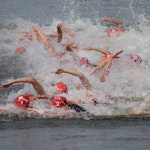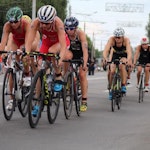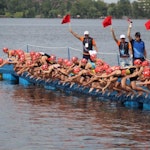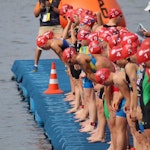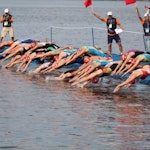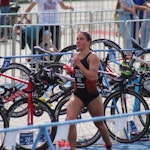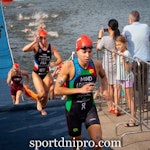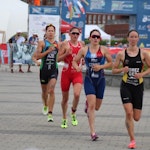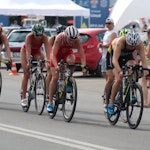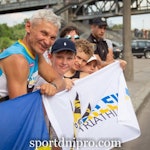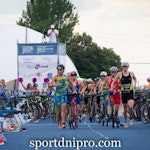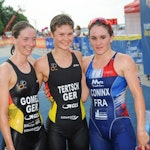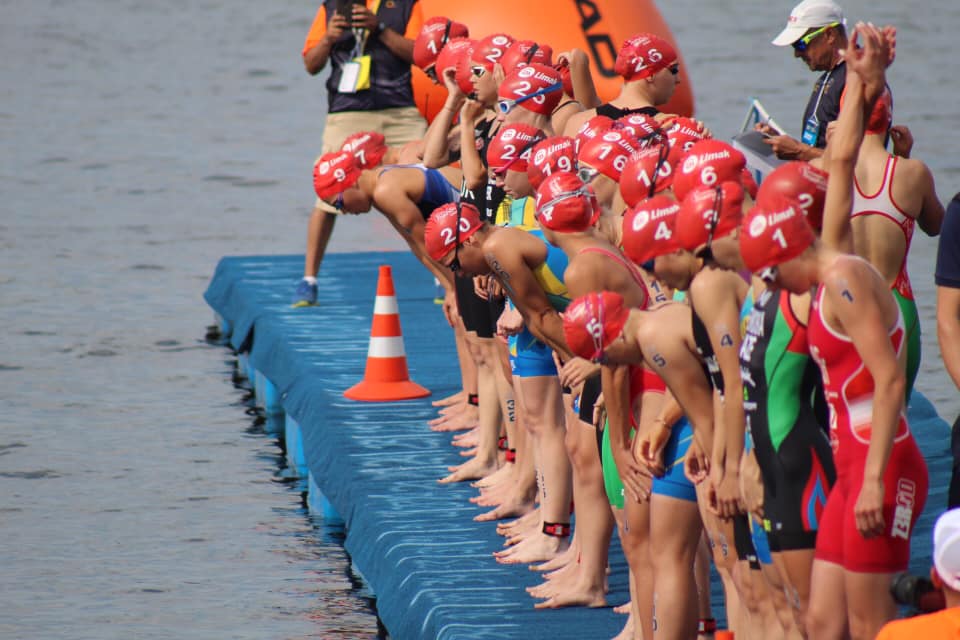
With the Elite Women selecting start positions close to the river bank, Sara Vilic AUT, wearing #1 was not alone at the start of the race.
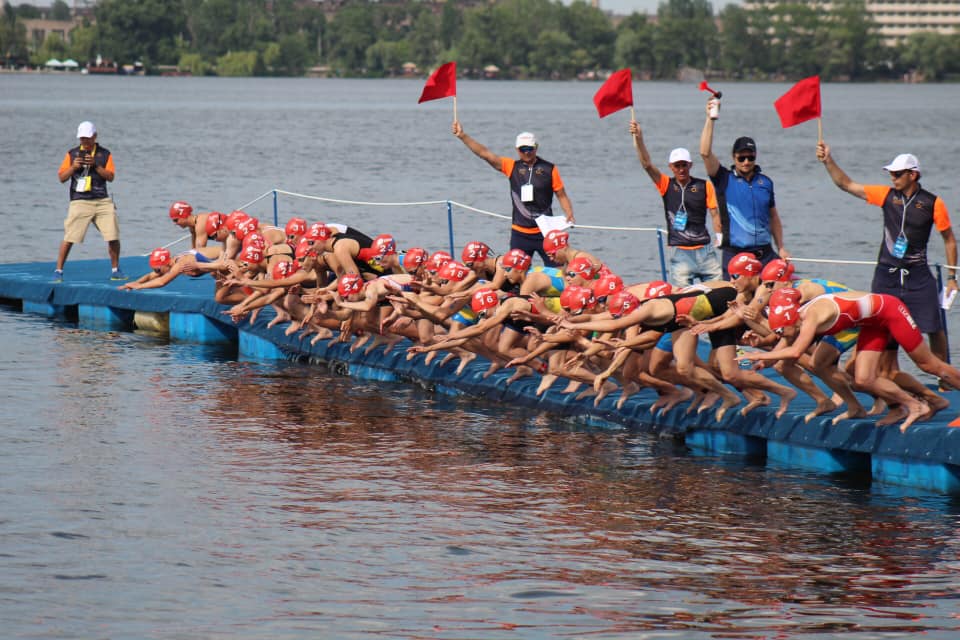
Some canny athletes went towards the end of the pontoon, knowing that whilst the water might be against them further away from the riverbank, they might have an easier opening couple of hundred metres of swimming and a better line to the turn buoys.
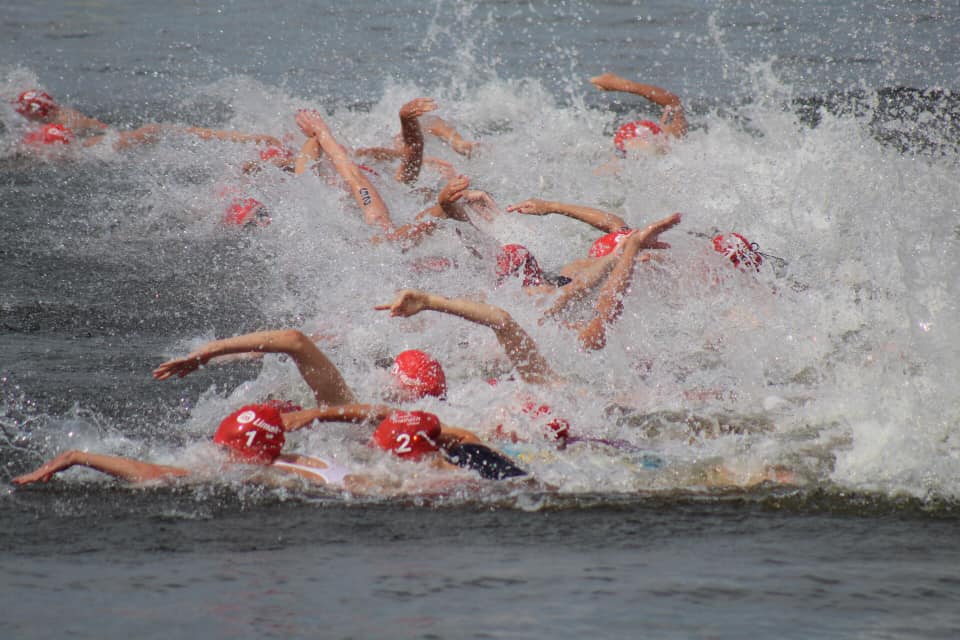
One of the last athletes to choose her start position was Germany’s Lisa Tertsch, who was a good way out and into the stronger current.
The first minute of swimming was intense for the athletes closer to the bank but for Russia’s Julia Brynkina a great start and good work in the water took her into a good position early on. Tertsch found her place too and by the time the athletes had reached the first turn buoy, there was a clear lead with Brynkina and Quinty Schoens NED. Behind but still close came a line of a dozen athletes, all trying to create space between them and the main pack. Now on the return, long and powerful strokes were needed.

Brynkina read the water well and moved deeper. Schoens looked as if she would be caught by the pack as the main body of athletes dropped back. The Russian was impressive and managed the turn across the current with ease, heading back to the bank and the swim exit. Realising that the faster waster was where she was swimming, the others moved deep.
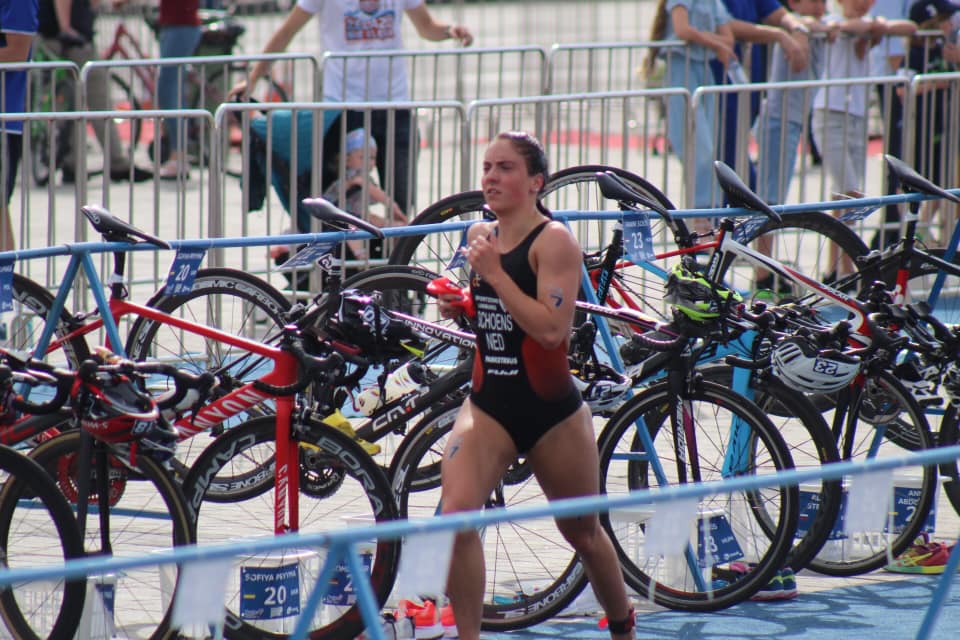
Brynkina lead them to the swim exit and then along the long run to T1. Schoens chased. Within this leading group were the main medal hopefuls. Levkovska was there. Vilic was there. In the chase pack was Sofiya Pryyma UKR, having missed out by a few seconds on the swim. Tucked in behind her was Léa Coninx FRA. Both strong cyclists, they would have to work hard now.
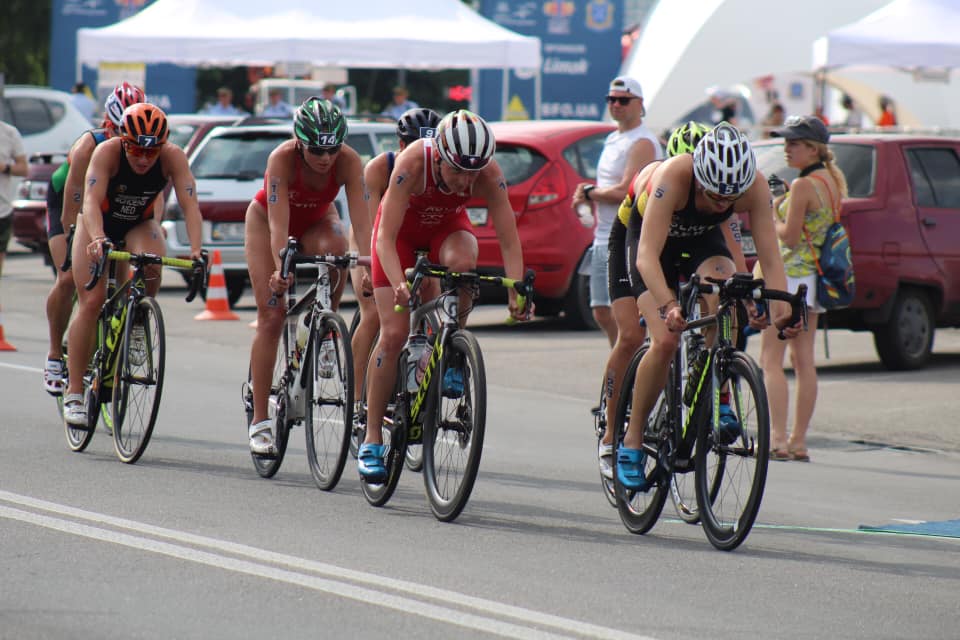
Out onto the bike course and 8 athletes set about their escape. The pace was good and two were dropped but with determination, were soon able to re-join the leaders. Schoens made sure the pace stayed strong. Kseniia Levkovska AZE was working hard. Célia Merle FRA took her turn at the front. The hill came and along with it an injection of pace. One off the back. Down to seven athletes now.
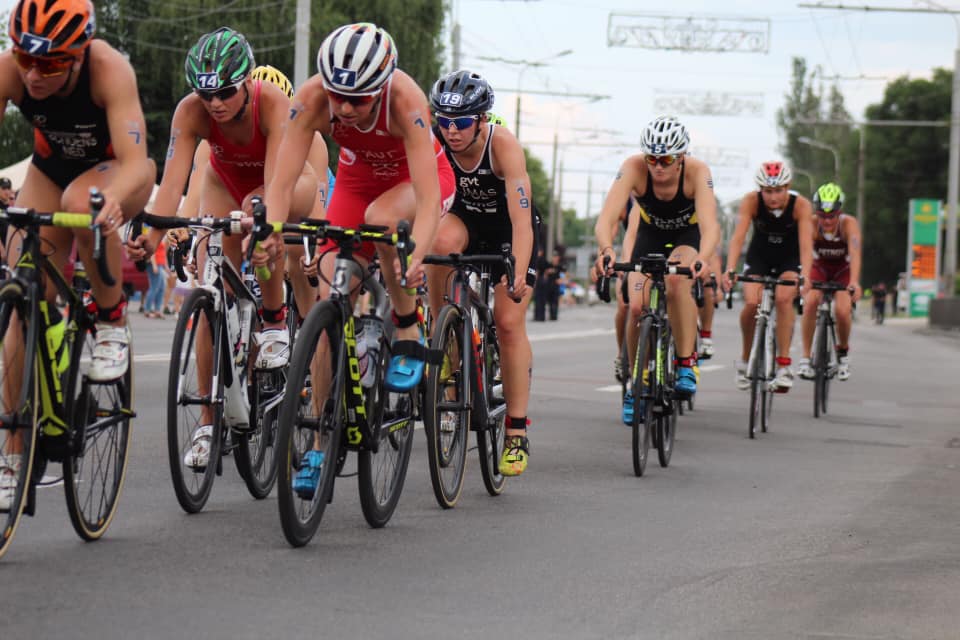
With the descent coming and a chance to build up a lead, it was a chance for Vilic to take control and soon enough the chain-gang started and with it, the increase of speed. High quality roads allowed the athletes to really push hard and they hit the flat section along the riverbank at speed. Germany had two athletes tucked in this group and together, they were making it fast. Tertsch, Marlene Gomez-Islinger and Line Völker. But not fast enough. Behind them and clearly visible on flat river-side road, the chasing athletes were catching.
The inevitable happened and as the leaders were making the climb, they were caught. All the hard work and effort was lost and the medal chances now, within the group were wide open. Rather than allowing the newly-arrived athletes to settle into a relaxing spin and get their breath back, the attacks from the front continued but the top of the climb saw a long line of athletes now.

Doubled in size, the medals could come from anywhere within the pack now and both Levkovska and Vilic had enough experience to know that there was no chance of easing off the speed now.
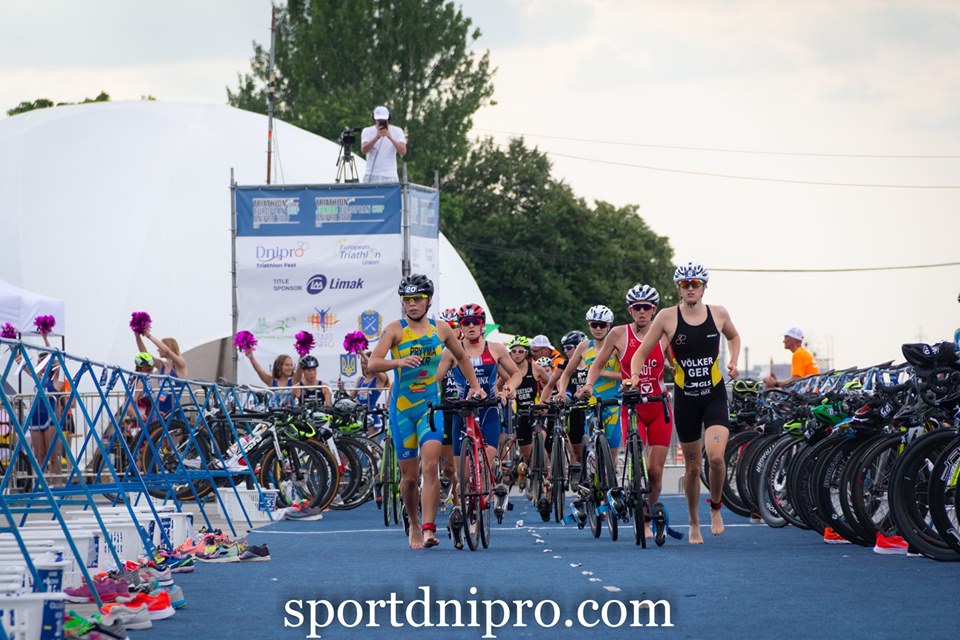
Into T2 and a speedy racking of the bike, stowing of the helmet in the box and, with the shoes on, it was a rush through the long channel out to the run course, with Coninx, Vilic and Tertsch breaking away initially, only to be joined by Völker, Gomez-Islinger, Schoens and Switzerland’s Alissa König. Tertsch looked supreme as she hit the end of the course. Running easy, she kicked up a gear and simply left the others foundering behind her. Her lead at the end of the first lap gave her a head on view of the opposition and nobody looked in a position to threaten her.
We knew that the young German athlete could run hard off the bike. Her victory in Kalkar as a junior was emphatic but now, racing Elite and against some top athletes, she was having the race of her life. Her position out front was a lonely one. As she hit the dead turn for the second time, she was able to see just how much of a lead she had created in just one lap.
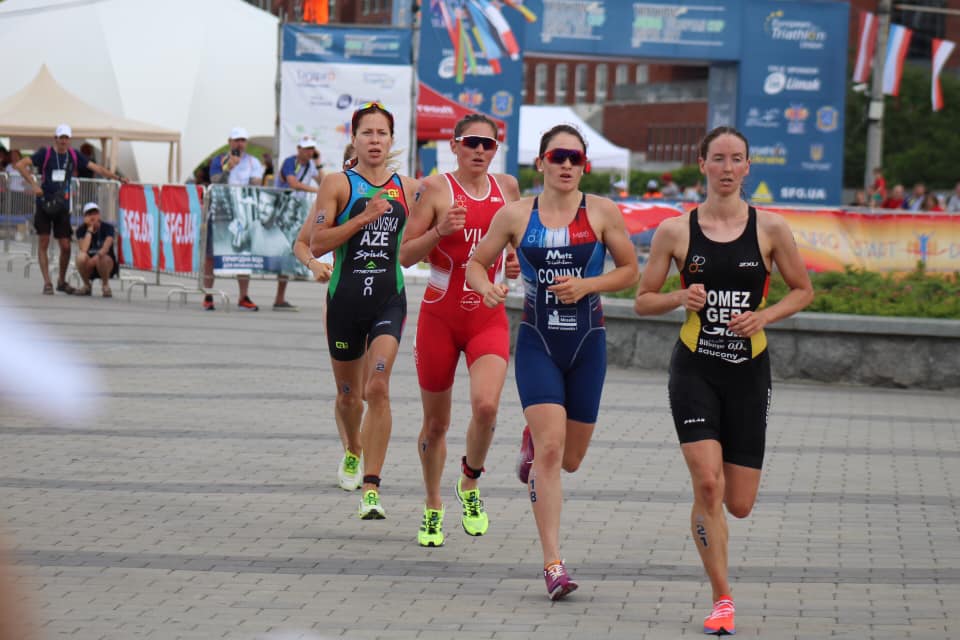
Chasing her, a group of four; Vilic, Gomez-Islinger, Coninx and Levkovska. Behind them, a void. The 26 second lead as she heard the bell was great news to her. Seeing her team-mate, Gomez-Islinger was event better news but there, chasing the chasers, was Annika Koch and the chance, with Koch’s power on the run, that there would be an all-German podium.
A check on positions at the final turn and Levkovska looked in a bad way. Coninx was struggling to hold onto bronze, while Gomez-Islinger was storming.
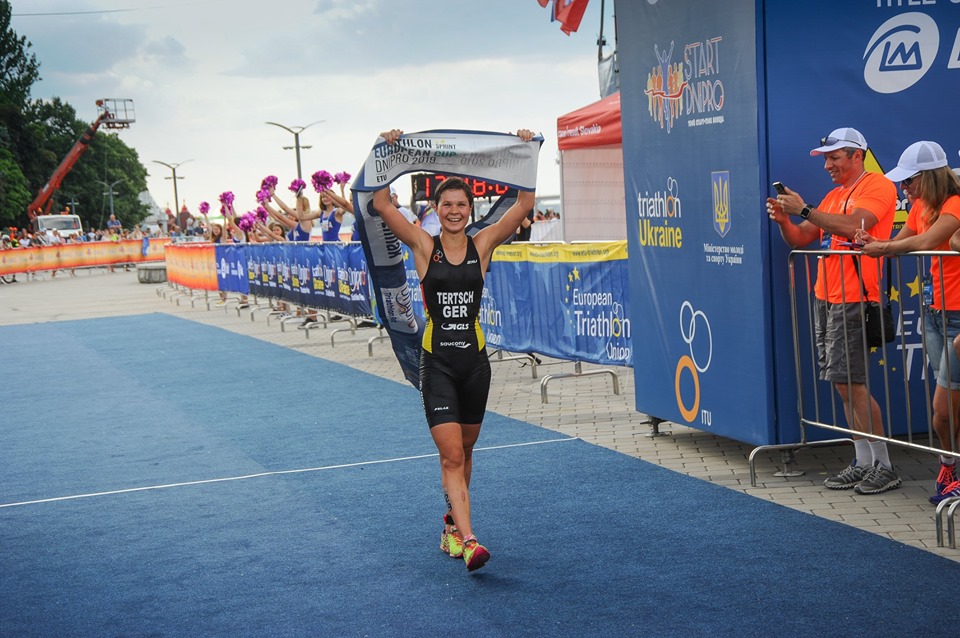
Tertsch claimed a magnificent victory.
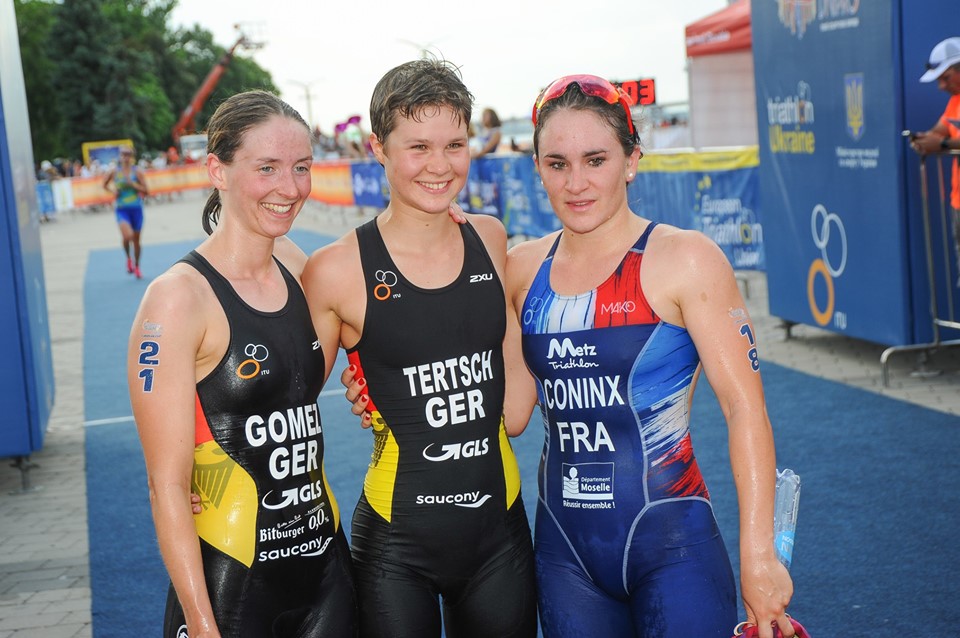
Her smile was massive and it was Germany, Germany and France as Coninx held off the late attack from Koch.
An unpredicted result but well-deserved.
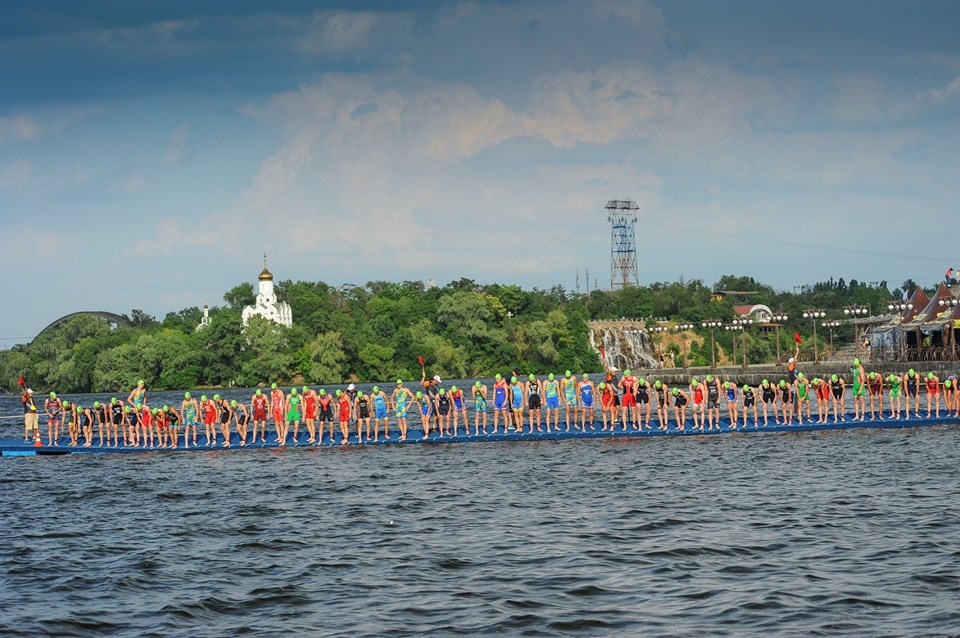
The crowds had been treated to a great race and next up it was the Elite men.
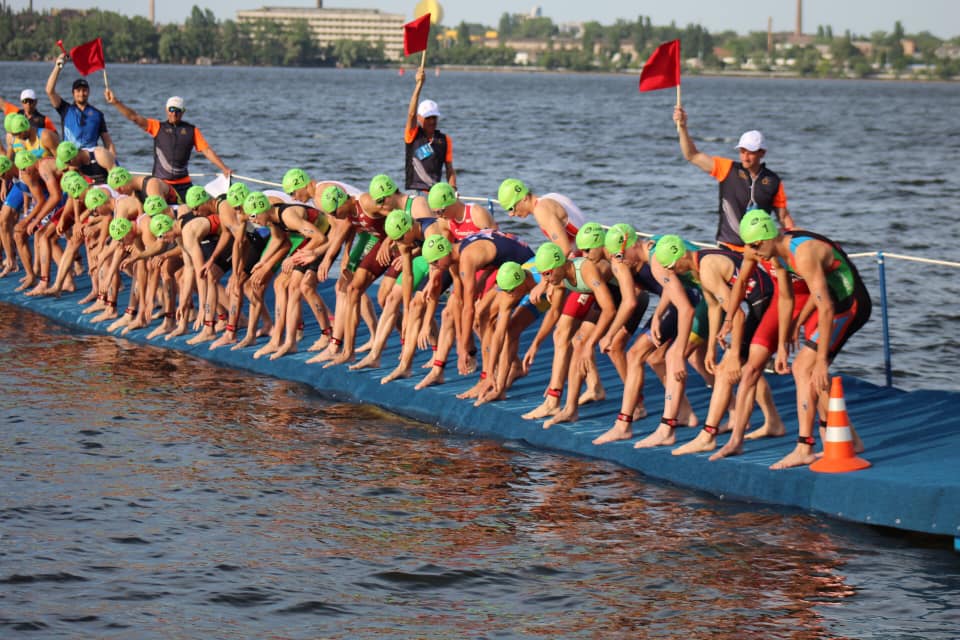
With his performance in Weert a clear signal that he was on form, Rostislav Pevtsov must have been confident that a podium, if not a win would be possible. Taking his place on the pontoon, he went for the slower water, just as had Vilic in the women’s race. Others headed out along the pontoon and the head-on current.
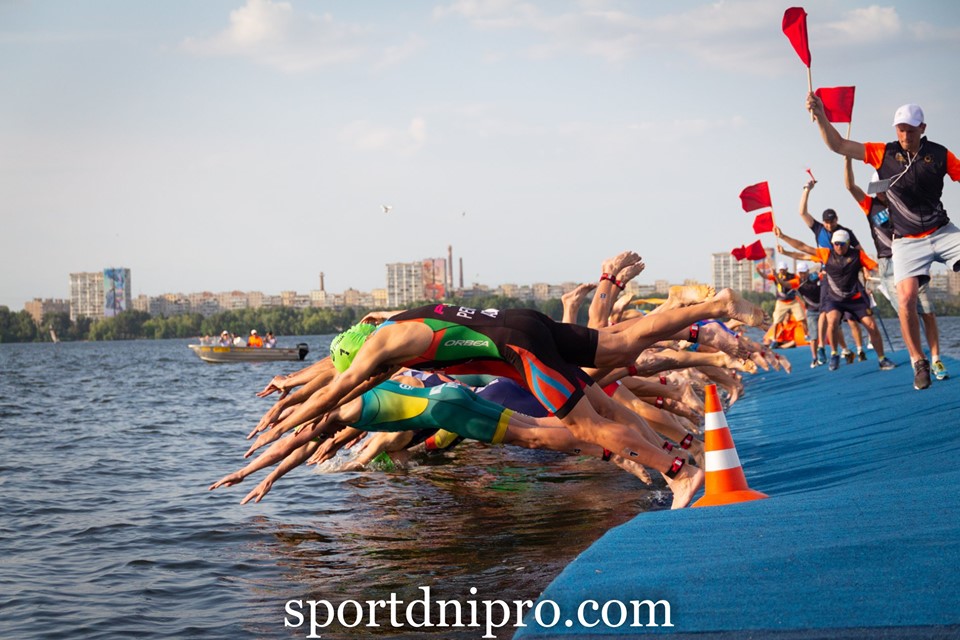
Just over 60 athletes on the pontoon. The officials were naturally concerned about the kick that would result from 60 bodies launching themselves off the blue carpet and into the river. A spectacular start saw the athletes set off and two distinct groups; one close to the banks of the river and one deeper.
It was this smaller group that got to the first buoy ahead of the pack and with long, deep strokes, we could see that it was once again a US athlete who had read the dark waters off the Dnipro to perfection, Chase McQueen. Back in 2018, it was Alec Wilimovsky who had gone deep to catch the faster water and get that all important place at the head of the race as they entered T1.
Two athletes at the front pulled the pack into a long line of chasing swimmers. McQueen looked strong. Behind him, Austria’s Lukas Kollegger and Ukraine’s Oleksiy Astafyev had created the smallest of leads, with Vladimir Turbaevskiy RUS working flat out to keep in contact with them.
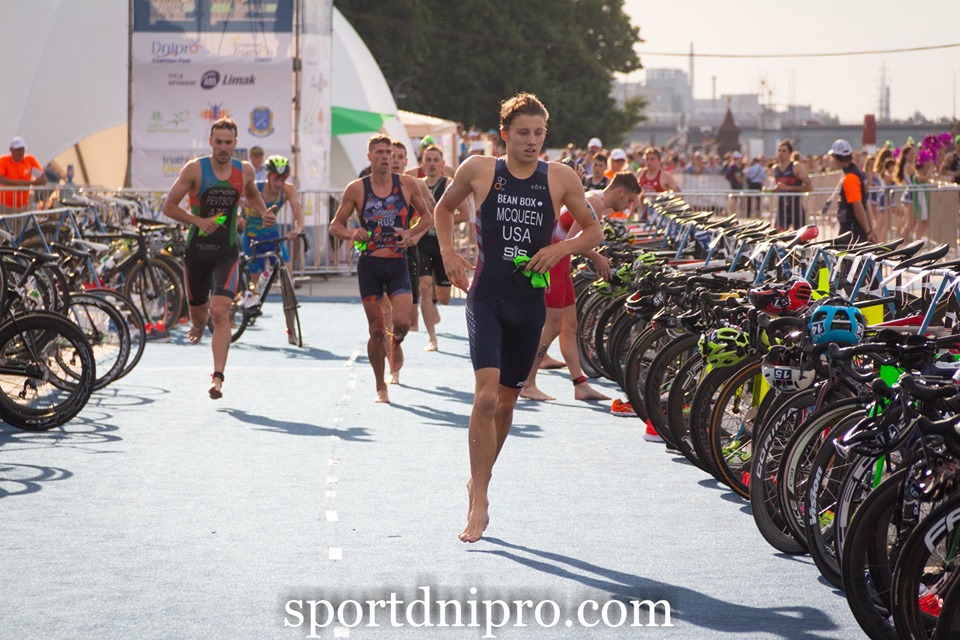
A line of athletes stretched back as they rounded the final buoy and began the battle across the current to reach the swim exit ramp. As they exited the water, USA, Austria, Ukraine, the frantic run to the transition area began and valuable seconds were re-captured.
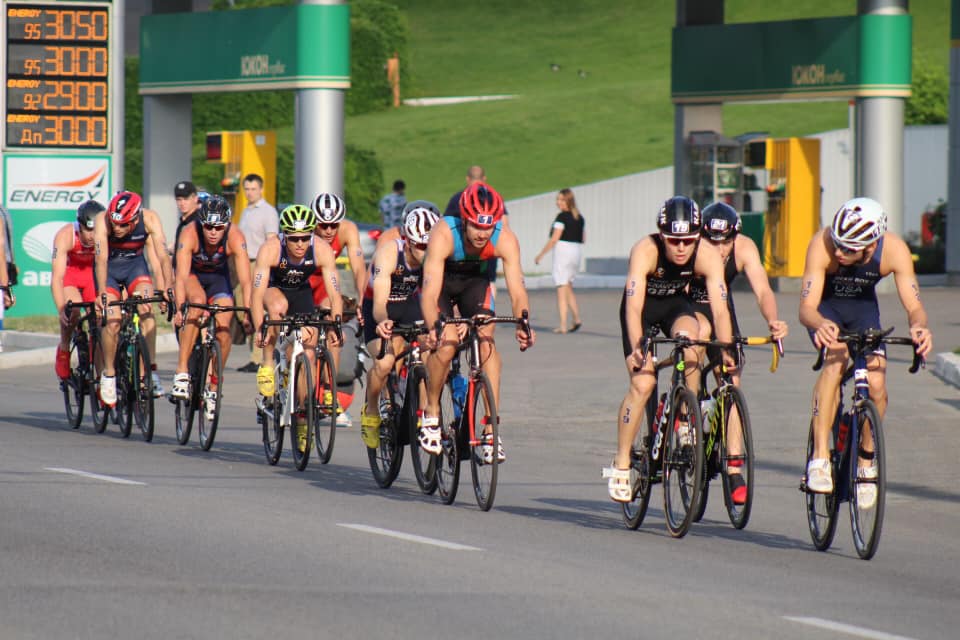
Pevtsov was well-placed but with no real break over the opening 750m, there was soon a sizeable group out on the 3-lap bike course.
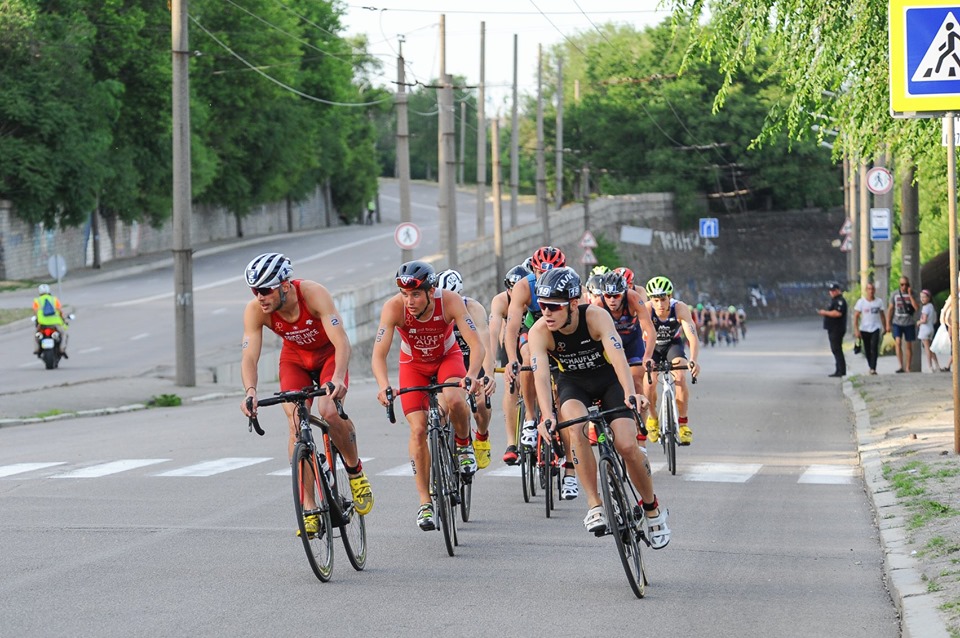
As they hit the 8% climb for the first time, the lead pack was a strong group of a dozen, they had managed to create a 13 second lead, with Pevtsov taking command and urging them on.

Having maintained the lead up the climb, the attack from behind was to be seen and it looked inevitable that one huge peloton would form. Back down onto the front and despite the high speed of the leaders and the control at the front from the Azerbaijan athlete, the chasing pack was nearing and as they approached the turn before the climb for the second time, the groups were together.
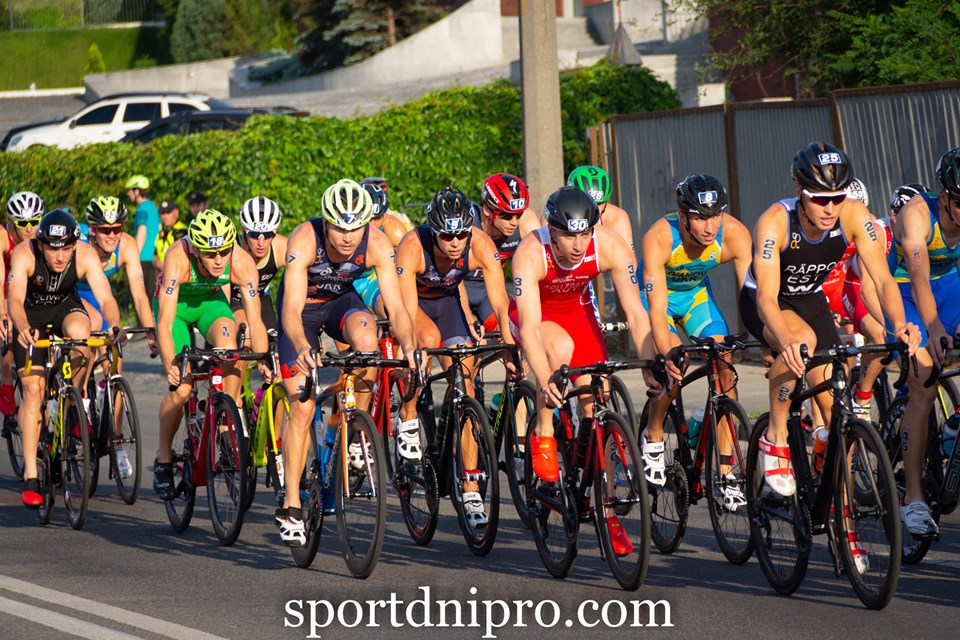
Rounding the turn in a huge group is always a challenge and now, doubled in size, caution was needed. The roads are wide and well maintained here and it was these favourable conditions that allowed the exciting break from Estonia’s Henry Räppo EST. He timed his attack on the climb to perfection and was gone before the rest could respond. Having attacked on the hill he then used the sweeping downhill section to build upon his advantage.
The massive peloton behind him took a while to get its act together but Räppo led all the way back down to and along the front. His glances back to see where the pack was indicated that his lead might soon be over. Ten seconds became five and then the lone figure was caught just in time to turn up towards the climb. Spread out across the road, the pack looked mightily impressive and for the organisers, these images were worth their weight in gold.
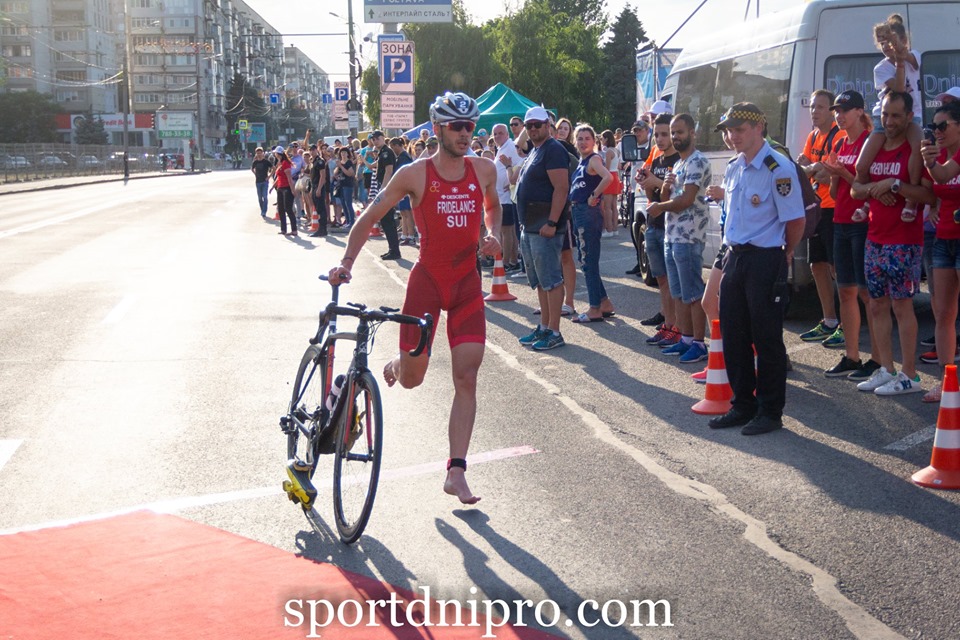
Attacking in the same place as the Estonian, it was Switzerland’s Sylvain Fridelance who injected some pace and using the same descent to power away, managed to create a 13-second lead that would allow him the clearest run into T2.
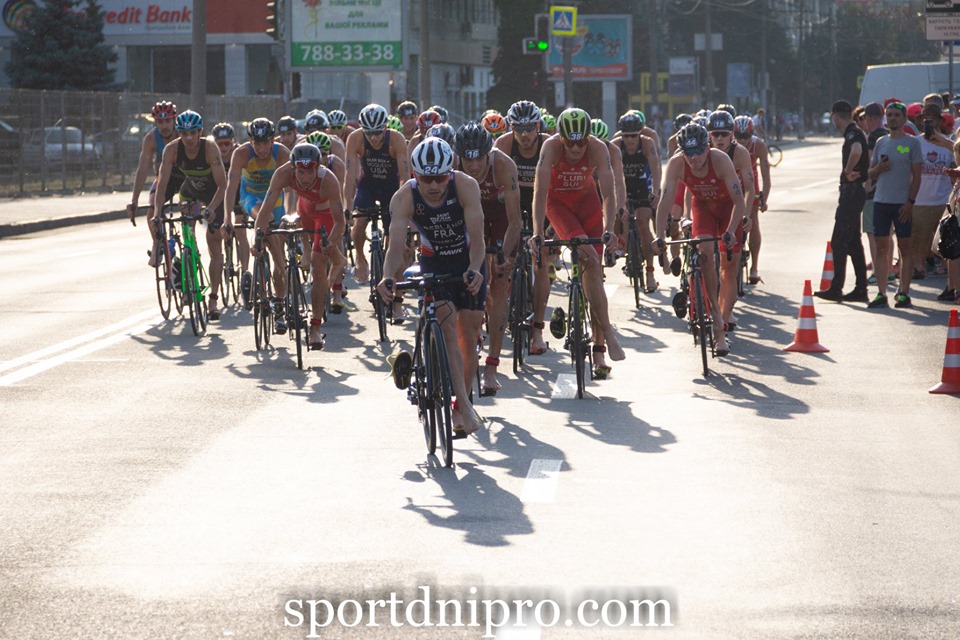
The last lap now. No room for errors for the pack. As they made their final approach to the dismount, feet out of their shoes, they jostled for position in the narrow corridor but were closing on Fridelance, who left T2 just as the main group were racking their bikes.
Could he run away with the victory? Behind him and closing, it was Arthur Berland but Leon Pauger AUT, then Lars Holenweger and Florin Salvisberg from Switzerland were on his heels.

Suddenly he was there. Pevtsov was racing past the early leaders and by the tie they had reached the end turn, the Azerbaijan athlete had taken the lead. Up there too was Aussie Callum McClusky. He has frequently been seen on the start lists at ETU races and has enjoyed podium appearances in the past but hare, he was up against some serious runners.
Choosing to follow Pevtsov, the pair broke away but as the first lap was nearing its end, Pevtsov looked the stronger. Head locked in the direction of the leader, McClusky dug deep and now with half the run over, was shoulder to shoulder with the race favourite. As they came to the bell, McCLusky kicked and took the lead. Pevtsov tucked in behind but was breathing deeply now. Fluri and Salvisberg were holding off the French hopes of Berland.
With just half a lap to go, the leaders were still close. Fluri was adrift by a few seconds. The long, straight and very hot run to the blue carpet, the finish tape, the prize-money and the points had begun. Could the Ukraine-born Pevtsov win? Was the Aussie, the young pretender, going to upset the crowds and snatch gold? The two upped the pace.
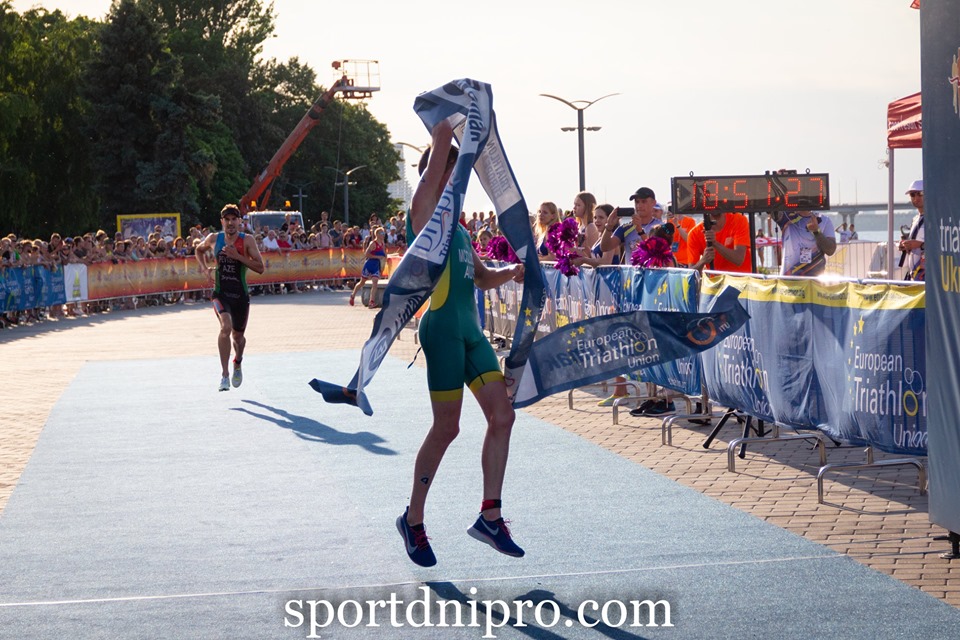
Applause rang out along the course and then, with 250m to go, McClusky went for it and Pevtsov had nothing left. A gold and green uniform ran all the way to the line. Jubilant, it was Gold to Australia.

Pevtsov hung on to take the silver and the battle of the red uniforms saw Salvisberg edge our Fluri for the bronze.
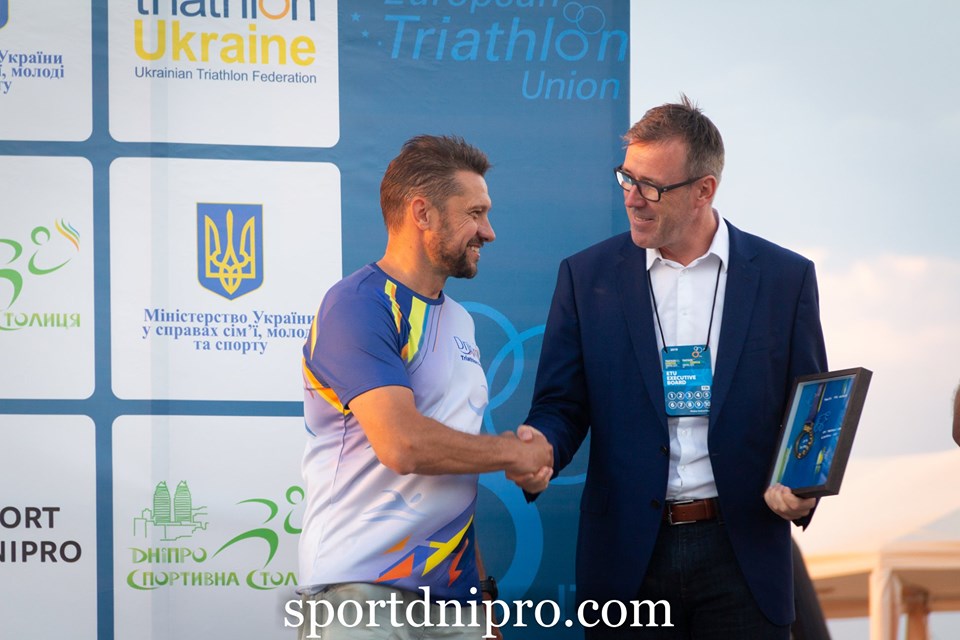
A great day of racing and a very special birthday present for the Event Organiser, Sergey Lysov, whose vision back in 2014 brought the race to the city and who has now established a solid, well-managed event that welcomes not only the Elite and Junior athletes from all over the world but one which has created a legacy for the sport in Ukraine. If you have a wish list for races, this has to be on it.
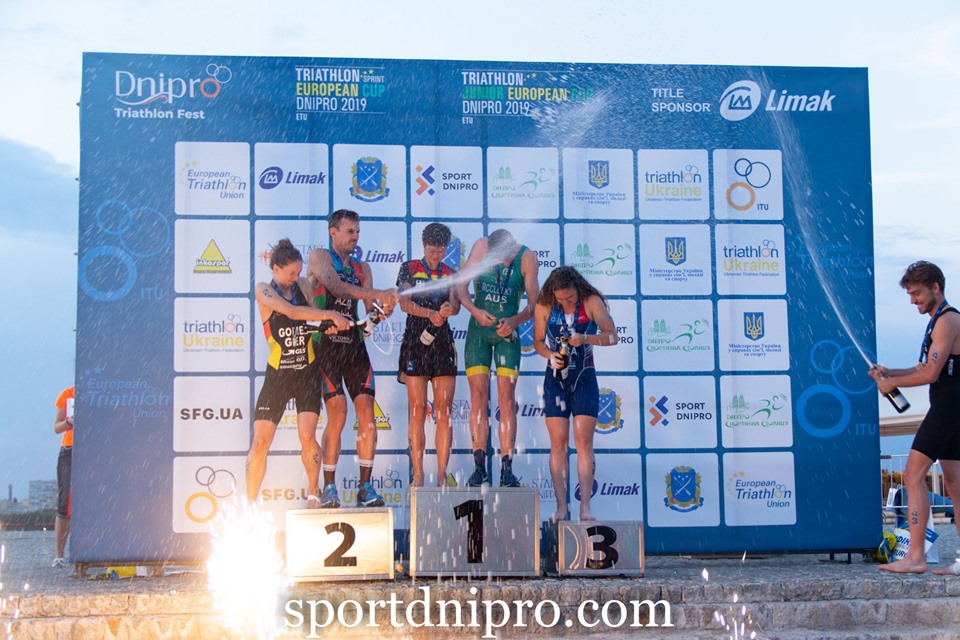
A very big thank you to sportdnipro.com and to Bachuki Darsaniia for his photos. Check out the albums here.
Article gallery
Related Event: 2019 Dnipro ETU Sprint Triathlon European Cup
| Results: Elite Men | |||
|---|---|---|---|
| 1. | Callum McClusky | AUS | 00:52:14 |
| 2. | Rostislav Pevtsov | AZE | 00:52:17 |
| 3. | Florin Salvisberg | SUI | 00:52:23 |
| 4. | Maxime Fluri | SUI | 00:52:25 |
| 5. | István Király | HUN | 00:52:30 |
| 6. | Arthur Berland | FRA | 00:52:33 |
| 7. | Vladimir Turbayevskiy | AIN | 00:52:36 |
| 8. | Louis Vitiello | FRA | 00:52:36 |
| 9. | Sylvain Fridelance | SUI | 00:52:44 |
| 10. | Yegor Martynenko | UKR | 00:52:46 |
| Results: Elite Women | |||
|---|---|---|---|
| 1. | Lisa Tertsch | GER | 00:58:02 |
| 2. | Marlene Gomez-Göggel | GER | 00:58:26 |
| 3. | Lea Coninx | FRA | 00:58:37 |
| 4. | Annika Koch | GER | 00:58:47 |
| 5. | Kseniia Levkovska | AZE | 00:58:53 |
| 6. | Sara Vilic | AUT | 00:59:00 |
| 7. | Alissa Konig | SUI | 00:59:04 |
| 8. | Quinty Schoens | NED | 00:59:35 |
| 9. | Alevtina Stetsenko | AIN | 00:59:51 |
| 10. | Marta Lagownik | POL | 00:59:54 |

